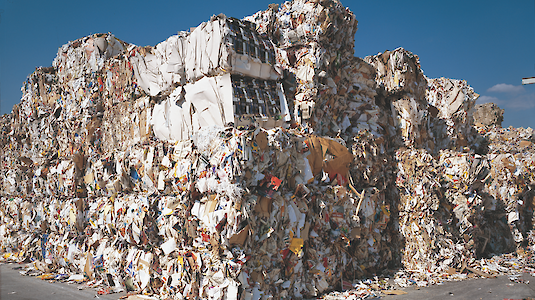Circular economy in the office
Paper is good for the circular economy. It can be recycled far more frequently than was assumed for years. This is shown by a study conducted by the Technical University of Darmstadt. According to the study, paper fibers can be recycled almost indefinitely. This means that waste paper is an even more valuable raw material than assumed.
The wood used for pulp production could also be used elsewhere, e.g. long-lasting in the construction sector. Get the circular economy in the office, use recycled paper products. In this light, sanitary paper made from fresh wood fibers, for which there is no second chance, seems like a no-go. They are lost for good. Our tip: Again, only use paper made from 100% recycled paper!
Paper is good for the circular economy - if it is recycled.
The TU Darmstadt 2018 study on the fiber life cycle of primary and secondary fibers refuted the limited life cycle of the fiber material of up to 7 times. Multiple recycling tests were carried out in laboratory trials, which concluded that no further significant change in fiber length and strength properties could be detected even after 25 recycling cycles had been carried out.
Fibers can thus be kept in the cycle for a long time while protecting the environment, since the raw material is optimally utilized in this way. The potential of recovered paper has thus long been underestimated. Waste paper is an even more valuable raw material than suspected.
Lower whiteness for office and toilet paper strengthens the circular economy
Paper with low whiteness grades also specifically promotes the circular economy, since mainly medium and lower grades of recovered paper are used for this purpose. High whiteness grades, on the other hand, are only possible through the use of so-called better grades (e.g. unprinted papers), for which, however, there is only a limited market. In the case of recycled papers without an Ecolabel, optical brighteners are also used to achieve high whiteness levels.
Sanitary paper - goodbye cellulose fiber!
In production, sanitary paper places a heavy burden on the environment, but also on the wallet. Sanitary paper requires a lot of wood, energy and water and leads to the discharge of hazardous substances into bodies of water. In any case, the valuable fibers are lost to the circular economy after use because they cannot be collected again. In addition, products made from recovered paper also perform much better than products made from virgin fibers from a financial point of view - with comparable usage properties.
Time for a change
For drying hands, as sanitary paper or for cosmetics - the demand for paper in bathrooms and toilets is high. Those who use products made from recycled paper instead of virgin fibers are acting with foresight. Buy sanitary paper such as paper handkerchiefs, toilet paper or kitchen roll made from 100 percent recycled paper (with government Ecolabel).
Office and printing paper made from 100 percent recycled paper with the Austrian Ecolabel and save paper.
If only labels such as the FSC or PEFC wood quality seal can be found on the packaging, this is not particularly helpful from an environmental point of view. These labels say something about forest or plantation management, but nothing about the use of pulp and paper chemicals, water and energy consumption in production. This does not matter for articles made of wood, but it does matter for paper products for office, school and household use.
What about paper consumption in general?
Internationally, it is still far too high. According to Austropapier, per capita paper consumption in Austria will be 208 kg in 2020.
This means that it has decreased from 244 kg to 208 kg over the last 20 years. (2000-2020). Nevertheless, Austria is still among the leaders in an international comparison.
It is also striking that the share of packaging paper has increased by almost 40% in the last 20 years, while consumption of graphic paper has decreased by around 23%, from 1.02 million tons to 617,857 tons.
As in Germany, the reason for the increase in packaging paper is the booming online trade.
Ready for a change?
Sustainability calculator
Calculate your savings with recycled paper here
https://www.papiernetz.de/informationen/nachhaltigkeitsrechner
Quick check
Protect biodiversity by buying the right paper!
VIDEO Recycled paper - Who approved it?
